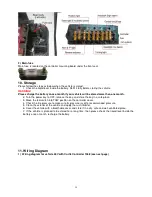
24
2) The lubricant for the rear power assembly must be applied and changed as per user’s manual.
3) The brake system must be adjusted once every 3 months.
4) The electric system must be checked once every 3 months (especially main circuit) for its fastening
parts and wiring connections. Meanwhile the contactor should be checked, any defective parts should be
replaced immediately. Clean any dust with low pressure air.
5) The electric contactors easily become hot if their mutual contact is not in good condition, so special
attention should be paid regularly to the electric contactors.
6) When changing the fuse, make sure that the new fuse is the correct rated current.
7) For the sake of safety, disconnect the positive pole from the battery when maintenance is done.
8) Never step the accelerator hard and frequently, which may shorten the life of the controller.
9) It is prohibited to fill any other liquids (such as battery additives, mineral water and tap water) into the
battery, ONLY the distilled water is allowed to fill in the battery.
10) Do not drive at high speed when going downhill; slow down the vehicle when turning; and remind the
passengers to hold on when turning and going downhill.
11) Children are not allowed to play in the vehicle; Children should be seated between adults and the
vehicle driven by adults when the vehicle is running.
8. Periodic Maintenance Charts
Regular maintenance is required for the best performance and safe operation of the vehicle.
WARNING!
Make sure to turn off the power key and apply the parking brake when you do the maintenance
unless otherwise specified. If the owner is not familiar with the vehicle maintenance, it should be
done by the dealer from whom you get your vehicle:
Periodic Maintenance Chart
1D
– per day
1W
– per week
1M
– per month
1Q
– per quarter
1Y
– per year
Item
Descriptions
1D
1W 1M 1Q 1Y
Battery
1. Check the liquid level. Please add the distilled
water if necessary.
Y
2. Charge the battery
Y
3. Tighten the nut on the battery cable
Y
4. Check to see if the battery is over-discharged (the
battery power meter flashing)
Y
5. Check the liquid density of the battery, standard
density should be 1.277±0.007g/
cm
3
(80
o
F. or 25 )
when the battery is fully charged.
Y
6. Check to see if the battery is charged fully by 2
ways: 1) Using the hydrometer. 2) Checking the
battery power meter.
Y
7. Clean the surface of the battery
Y
Charger
8. Observe the charging status, check to see if the
charger plug becomes hot.
Y
9. Clean the surface of the charger. Do not get any
water inside the charger.
Y



















